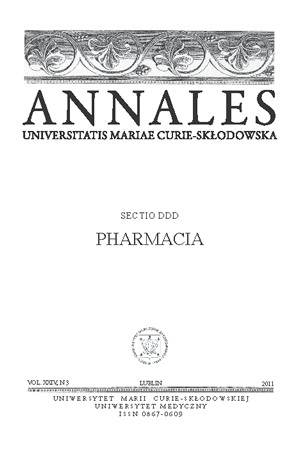Antioxidant properties of polyphenolic extracts from chokeberry, blackcurrant, blackberry, and raspberry fruits
DOI:
https://doi.org/10.12923/Keywords:
polyphenolic fractions, total phenolics, anthocyanins, ABTS, RosaceaeAbstract
Berry fruits are valuable source of polyphenolic compounds, which show high biological activity. They are characterized by great diversity in structure and antioxidant properties. The main phenolic compounds found in investigated fruits from Rosaceae family are: p-coumaric, caffeic and ferulic acids; anthocyanins, mainly cyaniding-3-glucoside derivatives; flavonols, commonly quercetin, myrycetin and kaempferol, and flavanols like (+) catechin and (-) epicatechin. In some species, in raspberry and blackberry for example, ellegic acid derivatives (hydrolysable tannins) are found in large quantities. In other ones, e.g. in chokeberry and blackberry, hydroxycinnamic acid derivatives such as chlorogenic and neochlorogenic acids dominate. Large variations in quality and quantity of phenolic compounds in fruits may explain their different antioxidant properties. The aim of this study was investigation of antioxidant activity of phenolic compounds in extracts obtained from chokeberry (CB), blackcurrant (BC), blackberry (BB), and raspberry (RB). The determination of total phenolic and anthocyanins content as well as ABTS test, were done in four fractions obtained with methanol (WA), ether (WB), ethyl acetate (WC) and water (WD). The richest in phenolic compounds were blackcurrant extracts (31-331 mg/g), then extracts from chokeberry (20-197 mg/g), raspberry (22-210 mg/g), and blackberry (46-113 mg/g). The highest content was determined in WB fraction (BC, CB, RB) and WC fraction (CB, BB). Total antioxidant activity against ABTS·+ radical cation decreased in order: CB >BC >BB > RB. The most active were ether (WB) and acetate (WC) fractions, which contain the majority of phenolic compounds. The correlation coefficient between total phenolic content and ABTS test was high (r = 0.94).
References
1. Amico V; Chillemi R; Mangiafico S; Spatafora C; Tringali C.: Polyphenol-enriched fractions from Sicilian grape pomace: HPLC-DAD analysis and antioxidant activity. Bioresource Technology, 99 (13), 5960, 2008.
2. Daniel, E.M., Krupnick, A.S., Heur, Y.H., Blinzler, J.A., Nims, R.W. and Stoner, G.D. Extraction, Stability And Quantification Of Ellagic Acid In Various Fruits And Nuts. J. Food Compost. Anal. 2, 338, 1989.
3. Foti, M.C., Johnson, E.R., Vinqvist, M.R., Wright, J.S., Barclay, L., Ross, C., Ingold, K.: Naphthalene diols: a new class of antioxidants. Intramolecular hydrogen bonding in catechols, naphthalene diols, and their aryloxyl radicals. J. Org. Chem. 67, 5190, 2002.
4. Gao X., Ohlander M., Jeppsson N., Bjork L., Trajkorski V.: Changes in antioxidant effects and their relationship to phytonurients in fruits of Sea buckthorn (Hippophae rhamnoides L.) during maturation. J. Agric. Food Chem., 48, 1485, 2000.
5. Giusti M.M., Wrolstad R.E.: Anthocyanins: Characterization and measurement with UV-visible spectroscopy. W: Wrolstad, R.E, editor. Current protocols in food analytical chemistry. John Wiley and Sons, New York 2001.
6. Hellström K, Törrönen R, Mattila P. : Proanthocyanidins in Common Food Products of Plant Origin. J. Agric. Food Chem. 57, 7899, 2009.
7. Oszmiański J., Wojdyło A.: Aronia melanocarpa phenolics and their antioxidant activity. Eur. Food Res. Technol. 221, 809, 2005.
8. Re R., Pellegrini N., Proteggente A., Pannala A., Yang M.: Antioxidant activity applying an improved ABTS radical cation decolorization assay. Free. Radic. Biol. Med. 26, 1231, 1999.
9. Rice-Evans C.A., Miller N.J., Paganga G.: Structure-antioxidant activity relationships of flavonoids and phenolic acids. Free Rad. Biol. Med. 20, 933, 1996.
10. Tabart J., Kevers C., Pincemail J., Defraigne J.O., Dommes J.: Comparative antioxidant capacities of phenolic compounds measured by various tests. Food Chem. 113, 1226, 2009.
11. Vangdal E., Slimestad R.: Methods To Determine Antioxidative Capacity In Fruit. Journal of Fruit and Ornamental Plant Research. 14 (Suppl. 2),123, 2006.
Downloads
Published
Issue
Section
License
Copyright (c) 2011 Authors

This work is licensed under a Creative Commons Attribution-NonCommercial-NoDerivatives 3.0 Unported License.


